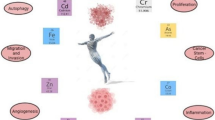Abstract
Cadmium is known as to be a potent pulmonary carcinogen to human beings and to induce prostate tumor. The sequestration of cadmium, an extremely toxic element to living cells, which is performed by biological ligands such as amino acids, peptides, proteins or enzymes is important to minimize its participation in such deleterious processes. The synthesis of metallothionein is induced by a wide range of metals, in which cadmium is a particularly potent inducer. This protein is usually associated with cadmium exposure in man. Because metallothioneins may act as a detoxification agent for cadmium and chelation involves sulfur donor atoms, we administered only cadmium, cysteine, or methionine to rats and also each of these S-amino acids together with cadmium and measured the production of superoxide radicals derived from the conversion of xanthine dehydrogenase to xanthine oxidase. It could be seen in this work that the presence of cadmium enhances this conversion. However, its inoculation with cysteine or methionine almost completely diminishes this effect and this can be the result of the fact that these amino acids complex Cd(II). Thus, these compounds can be a model of the action of metallothionein, removing cadmium from circulation and preventing its deleterious effect.
Similar content being viewed by others
References
S. J. Stohs and D. Bagchi, Oxidative mechanisms in the toxicity of metals ions, Free Radical Biol. Med. 18, 321–326 (1995).
G. M. N. Araujo, C. B. Silva, and A. Hasson-Voloch, Comparison of inhibitory effect of mercury and cadmium on the creatine kinase from Electrophorus electrus (L.), Int. J. Biochem. Cell. Biol. 28(4), 491–497 (1996).
M. Margoshes and B. L. Vallee, A cadmium protein from equine kidney cortex, J. Am. Chem. Soc. 79, 4813–4814 (1957).
H. Li and J. D. Otvos, 111Cd NMR studies of the domain specificity of Ag+ and Cu+ binding to metallothionein, Biochemistry 35, 13,929–13,936 (1996).
A. R. Green and M. J. Stillman, Oxidative quenching of luminescence from copper metallothionein, Inorg. Chim. Acta 226, 275–283 (1994).
P. J. Thornalley and M. Vasak, Possible role for metallothionein in protection against radiation-induced oxidative stress. Kinetics and mechanism of this reaction with superoxide and hydroxyl radicals, Biochem. Biophys. Acta 827, 36–44 (1985).
M. J. Stillman, F. C. Shaw III, and K. T. Suzuki (eds.), Metallothioneins, VCH, New York (1992).
M. Yoshida, H. Ohta, Y. Yamauchi, Y. Seki, M. Sagi, K. Yamazaki, et al., Age-dependent changes in metallotionein levels in liver and kidney of the japanese, Biol. Trace Element Res. 63, 167–175 (1998).
J. Hidalgo, L. Campmany, M. Borras, J. S. Garvey, and A. Armario, Metallothionein response to stress in rats: role in free radical scanvenging. Am. J. Physiol. 255, E518-E524 (1988).
M. Friedman, The Chemistry and Biochemistry of the Sulfhydryl Group in Amino Acids Peptides and Proteins, Pergamon, Oxford, UK (1973).
SQUERY, IUPAC. Stability Constants Database, Release 3, Academic Software, Timble, Otley, York, UK (1998).
E. Della Corte and F. Stirpe, The regulation of rat liver xanthine oxidase involvement of thiol groups in the conversion of the enzyme activity from dehydrogenase (type D) into oxidase (type O) and purification of the enzyme, Biochem. J. 126, 739–745 (1972).
M. G. Batelli, E. Della Corte, and F. Stirpe, Xanthine oxidase type D (dehydrogenase) in the intestine and other organs of the rat, Biochem. J. 126, 747–749 (1972).
O. R. Affonso, C. V. Ayres de Moura, V. Cavallari, and E. Mitidieri, Serum and liver xanthine oxidase in tumor bearing rats and mice, An. Acad. Bras. Ci. 53, 617–620 (1981).
S. Tan, Y. Yokoyama, E. Dickens, T. G. Cash, B. A. Freeman, and D. A. Parks, Xanthine oxidase activity in the circulation of rats following hemorrhagic shock, Free Radical Biol. Med. 15, 407–414 (1993).
F. Stirpe and E. Della Corte, The regulation of rat liver xanthine oxidase conversion in vitro of the enzyme activity from dehydrogenase (type D) to oxidase (type O). J. Biol. Chem. 244, 3855–3863 (1969).
R. Fried, Colorimetric determination of xanthine dehydrogenase by tetrazolium reduction, Anal. Biochem. 16, 427–432 (1966).
O. H. Lowry, N. J. Rosebrough, A. L. Farr, and R. J. Randall, Protein measurement with the Folin phenol reagent, J. Biol. Chem. 193, 265–275 (1951).
D. C. Montgomery, Design and Analysis of Experiments, Wiley, New York (1991).
M. J. Stillman, Metalothioneins, Coord. Chem. Rev. 144, 461–511 (1995).
Author information
Authors and Affiliations
Rights and permissions
About this article
Cite this article
Esteves, A.C., Felcman, J. Study of the effect of the administration of Cd(II), cysteine, methionine, and Cd(II) together with cysteine or methionine on the conversion of xanthine dehydrogenase into xanthine oxidase. Biol Trace Elem Res 76, 19–30 (2000). https://doi.org/10.1385/BTER:76:1:19
Received:
Revised:
Accepted:
Issue Date:
DOI: https://doi.org/10.1385/BTER:76:1:19




